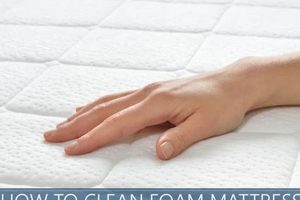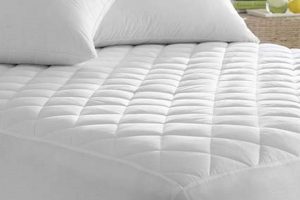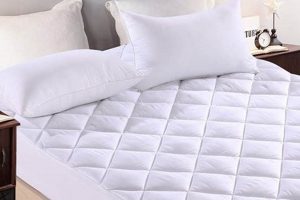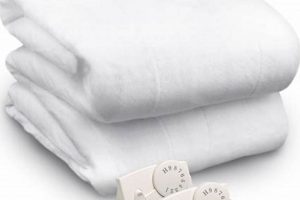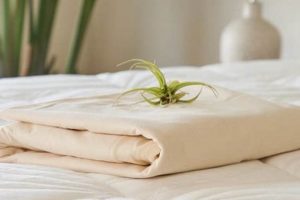Mattress pads and toppers both enhance sleep surfaces but offer distinct levels of support and protection. The former is a thin layer, typically quilted or fitted like a sheet, primarily designed to safeguard the mattress from spills and stains while adding a slight degree of comfort. A common example is a waterproof pad used to protect against accidents.
Choosing the correct sleep surface enhancement contributes significantly to sleep quality and mattress longevity. Historically, rudimentary versions of these products were employed to improve the hygiene and durability of mattresses. Modern iterations utilize advanced materials and construction techniques to offer specialized benefits like temperature regulation and pressure relief.
To understand which option best suits specific needs, a closer examination of their construction, function, and ideal applications is necessary. The subsequent sections will delve into these distinctions, providing a comprehensive overview of their respective advantages and disadvantages.
Key Considerations for Mattress Pad and Topper Selection
Selecting the optimal sleep surface enhancement requires careful evaluation. Several factors must be weighed to ensure the chosen product effectively addresses individual needs and preferences.
Tip 1: Assess the Primary Need: Determine whether the primary concern is mattress protection, enhanced comfort, or a combination of both. A pad is suitable for basic protection; a topper addresses significant comfort deficiencies.
Tip 2: Consider Material Composition: Evaluate the materials used in construction. Memory foam offers pressure relief, while down alternatives provide a plush feel. Material selection impacts breathability and temperature regulation.
Tip 3: Evaluate Thickness and Density: Toppers, generally thicker than pads, offer greater support and contouring. Consider the density of the material; higher density often equates to greater durability and support.
Tip 4: Examine Construction Quality: Look for reinforced stitching and secure attachment mechanisms. Quality construction ensures the product maintains its shape and performance over time.
Tip 5: Check for Certifications: Certifications such as Oeko-Tex indicate the product has been tested for harmful substances. This is particularly important for individuals with sensitivities or allergies.
Tip 6: Review Care Instructions: Understand the cleaning and maintenance requirements. Some materials may require professional cleaning, while others are machine washable.
Tip 7: Note Warranty and Return Policies: Understand the warranty provided by the manufacturer, as well as the seller’s return policies, before making the investment.
Careful consideration of these factors will ensure the selected product effectively addresses individual requirements, maximizing comfort and extending mattress lifespan.
The subsequent conclusion will consolidate the information presented, reinforcing the fundamental distinctions and guiding informed decision-making.
1. Thickness
Thickness is a primary differentiating factor between mattress pads and toppers, directly impacting their function and effectiveness. A mattress pad is characterized by its thin profile, typically ranging from a fraction of an inch to a maximum of two inches. This limited thickness dictates its primary purpose: to provide a protective barrier for the mattress. Examples include thin, quilted pads designed to absorb spills and prevent staining. The minimal thickness offers negligible impact on the mattress’s overall firmness or support.
Conversely, toppers exhibit a greater thickness, often ranging from two to four inches or more. This substantial dimension enables them to significantly alter the feel of the underlying mattress. Memory foam toppers, for instance, utilize their thickness to provide pressure relief by conforming to the body’s contours. A thicker latex topper can add firmness and support. The increase in material volume directly correlates with the level of comfort enhancement and support offered. Thicker toppers may also compensate for an aging or uncomfortable mattress by providing a new sleep surface.
Therefore, understanding the implications of thickness is crucial in differentiating between these products. A thin pad primarily serves a protective function, while a thicker topper provides a more substantial adjustment to the comfort and support characteristics of the mattress. Selecting the appropriate thickness depends on the desired outcome: basic protection versus significant alteration of the sleeping experience.
2. Support
Support is a critical differentiator. It dictates how effectively each product contributes to spinal alignment and pressure relief. Understanding the level of support each provides is crucial for selecting the appropriate sleep surface enhancement.
- Spinal Alignment Contribution
Mattress pads, owing to their minimal thickness, contribute negligibly to spinal alignment. Their primary function is not to correct posture or provide ergonomic support. Conversely, toppers, particularly those constructed from memory foam or latex, can significantly influence spinal alignment. They contour to the body, filling gaps and reducing pressure points, thereby promoting a more neutral spinal posture during sleep.
- Pressure Relief Capacity
Mattress pads offer limited pressure relief. Their thin layer provides minimal cushioning and does not redistribute weight effectively. Toppers, especially those with pressure-relieving materials like memory foam, excel in this area. They distribute weight more evenly across the sleep surface, reducing pressure on sensitive areas such as the hips and shoulders. This is beneficial for individuals experiencing joint pain or discomfort.
- Firmness Adjustment Capabilities
Mattress pads do not substantially alter the firmness of the underlying mattress. Their impact is primarily limited to adding a slight degree of softness. Toppers, however, can significantly modify mattress firmness. A firm topper can increase the support of a soft mattress, while a softer topper can alleviate the discomfort of an overly firm mattress. This makes toppers a viable option for customizing the feel of a sleep surface without replacing the entire mattress.
- Long-Term Support Maintenance
The support provided by mattress pads is generally consistent throughout their lifespan, as they do not undergo significant compression or degradation. Toppers, depending on their material composition and density, may experience some loss of support over time. Lower-quality memory foam toppers, for example, may compress and lose their ability to contour effectively. Higher-density latex toppers tend to maintain
their support characteristics for a longer duration.
In summary, the level of support offered constitutes a key distinction. Pads offer minimal support and are primarily intended for protection, whereas toppers are specifically designed to enhance support, improve spinal alignment, and alleviate pressure points. Selecting the appropriate product hinges on an individual’s specific support needs and preferences. For individuals with existing support deficiencies, a topper is generally the more suitable choice.
3. Protection
Protection forms a key distinction between mattress pads and toppers, influencing their suitability for diverse needs. Pads primarily serve as a shield against spills, stains, and allergens. The thin construction acts as a barrier, preventing liquids and particulate matter from penetrating the mattress core. A waterproof mattress pad, for instance, protects against accidental spills from children or pets. Without this protective layer, mattresses are susceptible to permanent staining and potential mold growth, impacting hygiene and longevity. Their purpose is not intended to add the comfort.
Toppers, while offering a degree of surface protection, prioritize comfort and support enhancement. Their thicker construction may absorb minor spills, but they are not inherently designed for comprehensive spill protection. A memory foam topper, for example, is vulnerable to liquid damage and requires an additional protective layer if safeguarding against spills is a primary concern. Although some toppers have washable covers to aid in the cleaning of small spots, the material may not be waterproof. They offer limited defense against dust mites and allergens penetrating from beneath due to their increased thickness.
In conclusion, protection capabilities differentiate mattress pads and toppers. Mattress pads should be chosen to provide a barrier against hazards that can affect mattress longevity. Although toppers are able to provide some protection against debris and allergens, they are intended primarily to modify the comfort of the bed itself. Users can choose appropriate levels of protection by being aware of these variations. The material properties have an influence on protection.
4. Material
The material composition of mattress pads and toppers fundamentally dictates their performance characteristics and differentiates their intended applications. Mattress pads frequently utilize materials like cotton, polyester blends, or waterproof laminates. These materials prioritize surface protection, breathability, and ease of cleaning. For example, a cotton pad offers basic comfort and moisture absorption, while a polyester blend enhances durability. Waterproof laminates provide an impermeable barrier against spills, preventing damage to the underlying mattress. The choice of material directly influences the pad’s ability to safeguard the mattress from wear and tear, stains, and allergens.
In contrast, toppers employ a wider array of materials chosen for their comfort and support properties. Common materials include memory foam, latex, down alternatives (such as gel fiber), and even down feathers. Memory foam toppers conform to the body’s contours, offering pressure relief and motion isolation, while latex provides a more responsive and supportive feel. Down alternatives mimic the plushness of down but are hypoallergenic. The material directly influences the topper’s ability to modify the firmness of the existing mattress, improve spinal alignment, and enhance overall sleep quality. For instance, a latex topper can add firmness to a soft mattress, while a memory foam topper can alleviate pressure points on a firm mattress.
The selection of materials has a practical significance in determining the suitability of each product for specific needs. If the primary goal is mattress protection and ease of care, a pad constructed from cotton, polyester, or a waterproof laminate is the appropriate choice. However, if the aim is to improve comfort, support, or address pressure points, a topper utilizing materials like memory foam, latex, or down alternatives is necessary. The material composition directly impacts the product’s ability to meet these distinct functional requirements, highlighting its critical role in differentiating pads and toppers.
5. Purpose
The intended function significantly differentiates mattress pads from toppers. This disparity dictates their design, materials, and suitability for specific needs. Determining the primary objective protection, comfort enhancement, or support is essential for selecting the appropriate product.
- Mattress Protection
Mattress pads serve predominantly as a protective barrier. This involves safeguarding the mattress against spills, stains, allergens, and general wear. For instance, a waterproof pad prevents liquids from penetrating the mattress, protecting against mold growth and extending its lifespan. The core aim is preservation and hygiene maintenance.
- Comfort Enhancement
Toppers, in contrast, focus on altering the sleep surface’s comfort characteristics. They can add cushioning, pressure relief, or temperature regulation. A memory foam topper, for example, conforms to the body to alleviate pressure points, while a cooling gel topper can mitigate overheating. The emphasis is on improving the tactile experience of the mattress.
- Support Augmentation
Certain toppers are designed to modify the level of support provided by the existing mattress. A firm latex topper can increase the support of a sagging mattress, while a softer topper can alleviate the discomfort of an overly firm mattress. The intent is to address underlying support deficiencies.
- Customization of Sleep Experience
Both pads and toppers allow for a degree of customization. However, pads are limited to subtle adjustments, such as adding a slight layer of cushioning. Toppers offer a more substantial means of tailoring the sleep experience, allowing for significant alterations in firmness, pressure relief, and temperature regulation. This is exemplified by individuals who add a pillow-top mattress topper to a firm mattress in order to make it more plush.
These distinctions highlight how purpose informs the design and functionality of each product. Mattress pads prioritize protection and hygiene, while toppers emphasize comfort, support, and personalization of the sleep environment. Understanding these divergent aims is crucial for aligning product selection with specific sleep requirements and preferences. Individuals seeking primarily to safeguard their mattress should opt for a pad; those seeking to transform the feel of their mattress should consider a topper.
6. Cost
The financial investment required represents a significant point of divergence between mattress pads and toppers. Understanding the cost implications associated with each product is essential for informed decision-making. This consideration encompasses initial purchase price, long-term value, and poten
tial replacement expenses.
- Initial Purchase Price
Mattress pads generally have a lower initial cost than toppers. Their simpler construction and less specialized materials contribute to a more accessible price point. For instance, a basic quilted mattress pad may cost significantly less than a memory foam topper of comparable size. This makes pads an attractive option for budget-conscious consumers.
- Material and Construction Influence
The materials used and the complexity of construction directly impact the cost. Toppers utilizing high-density memory foam, natural latex, or intricate designs command higher prices. A topper with cooling technology or zoned support may also incur a greater expense compared to a basic foam model. Similarly, a pad made of organic cotton or with specialized waterproofing features will typically be more expensive than a standard polyester pad.
- Longevity and Replacement Cycle
The expected lifespan and replacement cycle affect the overall cost. Mattress pads, while less expensive initially, may require more frequent replacement due to wear and tear or diminished protective capabilities. High-quality toppers, although a greater upfront investment, may offer a longer lifespan and maintain their performance characteristics for an extended period. Consequently, a cost-benefit analysis considering longevity is prudent.
- Long-term Investment and Value Proposition
The value for money is not solely determined by the purchase price, but by the product’s lifespan and the comfort. Because toppers provide better comfort on low-budget mattresses compared to mattress pads, the consumers may see the value for long-term in mattress topper.
In summary, while mattress pads offer a lower initial cost, the long-term value proposition must consider the material, construction, and longevity of both options. Higher initial investment on a topper may, in some cases, prove more economical over the lifespan of the product, particularly when factoring in the benefits of enhanced comfort and support. Evaluating these cost-related factors facilitates an informed purchasing decision aligned with individual budgetary constraints and sleep needs.
Frequently Asked Questions
This section addresses common inquiries and clarifies misconceptions surrounding the distinction between mattress pads and toppers. The intent is to provide clear, concise answers based on factual information.
Question 1: Is one product inherently superior to the other?
Neither product is inherently superior; their suitability depends on individual needs. A mattress pad excels at protection, while a topper provides comfort and support enhancement. The optimal choice aligns with specific priorities.
Question 2: Can a topper fully rejuvenate an old, sagging mattress?
While a topper can improve comfort and provide some support, it cannot fully restore a severely sagging mattress. A topper offers a surface-level solution, but fundamental structural issues require mattress replacement.
Question 3: Are all mattress pads waterproof?
No, not all mattress pads are waterproof. Waterproof pads utilize a specialized laminate to prevent liquid penetration. Standard pads offer minimal protection against spills.
Question 4: How does topper thickness influence its performance?
Topper thickness directly correlates with its impact on comfort and support. Thicker toppers generally provide greater pressure relief and more significant alterations to mattress firmness.
Question 5: Can a topper exacerbate overheating during sleep?
Certain toppers, particularly those made of dense memory foam, can retain heat. Selecting a topper with cooling technologies or breathable materials can mitigate this issue.
Question 6: How can the longevity of a topper be maximized?
Topper longevity can be extended through proper care, including regular cleaning and the use of a protective cover. Rotating the topper periodically can also prevent uneven wear.
In summary, understanding the specific attributes and limitations of mattress pads and toppers facilitates informed decision-making. Assessing individual needs and prioritizing key features ensures selection of the product best suited to enhance sleep quality.
The next section provides a consolidated conclusion, summarizing the fundamental distinctions and offering guidance for making the optimal choice.
Difference Between a Mattress Pad and Topper
The preceding exploration of the “difference between a mattress pad and topper” reveals fundamental distinctions that dictate their suitability. Mattress pads primarily function as protective barriers, safeguarding against spills, stains, and allergens. Toppers, conversely, serve to enhance comfort, augment support, and modify the overall sleep experience. Material composition, thickness, intended purpose, and cost all contribute to these divergent roles. The ultimate selection hinges upon a careful assessment of individual needs and priorities, balancing the necessity for protection against the desire for enhanced sleep quality.
Recognizing these critical distinctions empowers informed decision-making, ensuring that the chosen product effectively addresses specific requirements. A considered approach, informed by a clear understanding of the functionalities and limitations of each option, will optimize sleep quality and contribute to the long-term preservation of the mattress investment. The decision to purchase a pad or a topper should reflect a deliberate alignment with established needs, not a hasty compromise driven by incomplete information.



